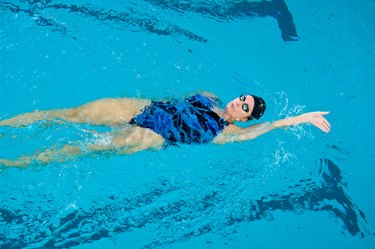
Swimming offers many benefits as a full-body exercise. Every stroke uses multiple large muscle groups in your upper and lower extremities while placing far less stress on your joints than land-based exercises. The backstroke, which uses different body positioning than other competitive strokes, activates a unique combination of muscles. Jim Montgomery, co-author of "Mastering Swimming," recommends adding the backstroke to your swimming regimen for a more complete workout and better muscle balance.
Back and Chest
Video of the Day
Competitive strokes that require a face-down position in the pool use your pectoralis major as the primary driver to propel your body through the water. According to "Swimming Anatomy," the backstroke recruits the pectoralis major to a lesser extent. The backstroke's propulsion phase is dominated by the latissimus dorsi, which are the muscles spread across your upper back. Although your lats are the primary muscles in propelling your through the backstroke, your pectoralis major remains active to some extent throughout the stroke.
Video of the Day
Legs
The backstroke uses a combination of the kicking motions used in the freestyle and butterfly strokes. At the start of a lap, you use a dolphin kick, similar to the kicking mechanics of the butterfly; you also use the dolphin kick at the wall. Once swimming, however, you switch to reciprocating movements similar to a freestyle kick. Both styles of kicking, as "Swimming Anatomy" notes, engage your gluteal muscles, rectus femoris, quadriceps and hamstrings. The text "Mastering Swimming" recommends a swimming routine that includes both freestyle and backstroke. Because the greatest water resistance is in the downward kick, the face up position of the backstroke works muscle groups opposite of those primarily used in freestyle.
Arms
The biceps are a primary muscle used in the backstroke. After the fingers enter the water, with your arm extended, your biceps must bend your arm through the water to a 90-degree angle before you reach the finishing phase of the stroke and begin another on the opposite side. Ian McLeod, author of "Swimming Anatomy," points out that the forces required to extend your elbow during the final phase of the backstroke place a great demand on your triceps, as well.
Core
All competitive strokes engage your core muscles. Because the backstroke recruits your core differently from other strokes, backstroke is an excellent complementary exercise to freestyle. Practicing both leads to greater muscle balance. The dolphin kicks performed during the backstroke create an undulating movement that, according to "Swimming Anatomy," activates your core stabilizers. Meanwhile, reciprocal kicking recruits your lower back muscles. The hip rotation, caused by the side-to-side movements of your upper body during the backstroke, engages your abdominal muscles.